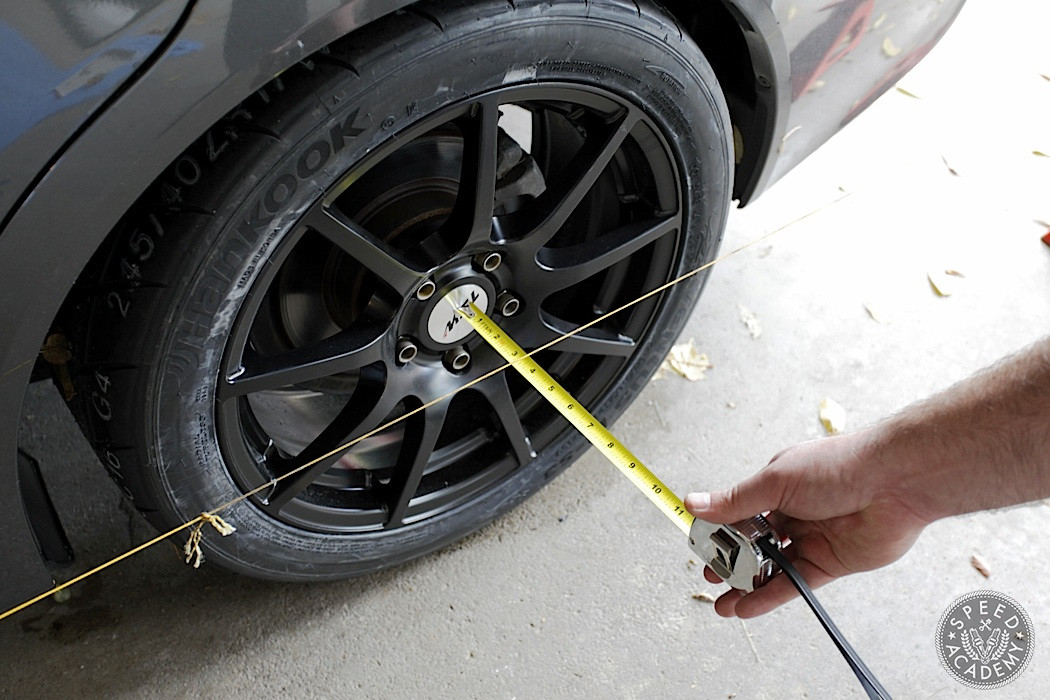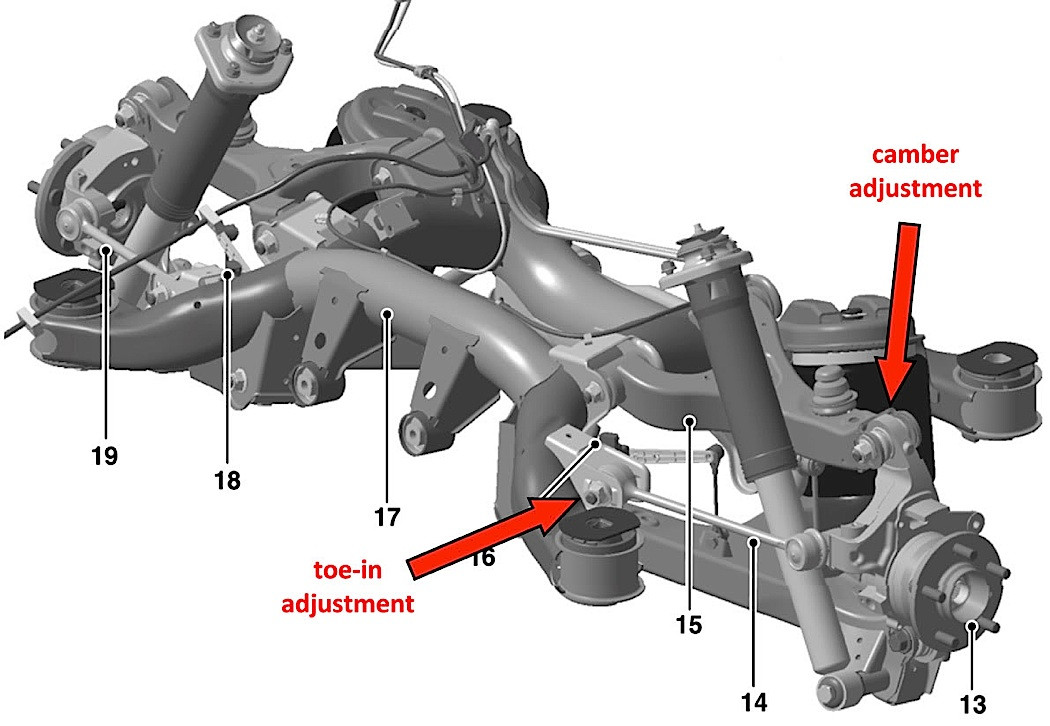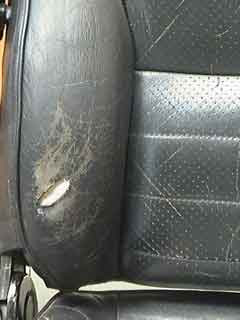How To Fix Alignment In Car: A Complete Guide

Fixing alignment in your car ensures optimal handling, tire life, and safety. Discover the best tools and techniques at CARDIAGTECH.NET for accurate wheel alignment, enhancing your vehicle’s performance. Proper alignment prevents uneven tire wear, improves fuel efficiency, and offers a smoother driving experience, making it a crucial aspect of vehicle maintenance and performance tuning.
1. Understanding Car Alignment
Car alignment, also known as wheel alignment, involves adjusting the angles of your vehicle’s wheels to meet the manufacturer’s specifications. This process ensures that the wheels are parallel to each other and perpendicular to the road, maximizing tire life and optimizing handling. Proper alignment is crucial for vehicle safety, fuel efficiency, and overall driving comfort.
1.1. Key Alignment Angles
Understanding the three main alignment angles—toe, camber, and caster—is crucial for diagnosing and correcting alignment issues. Each angle affects vehicle handling and tire wear in unique ways.
- Toe: Refers to the inward or outward angle of the wheels when viewed from above.
- Toe-in (positive toe): The front of the wheels points inward.
- Toe-out (negative toe): The front of the wheels points outward.
- Proper toe alignment ensures even tire wear and straight-line stability. According to the National Highway Traffic Safety Administration (NHTSA), incorrect toe settings are a common cause of premature tire wear.
- Camber: The inward or outward tilt of the wheels when viewed from the front of the vehicle.
- Positive camber: The top of the wheel tilts outward.
- Negative camber: The top of the wheel tilts inward.
- Camber affects cornering ability and tire wear. Performance cars often use negative camber to improve grip during turns.
- Caster: The angle of the steering axis when viewed from the side of the vehicle.
- Positive caster: The steering axis tilts toward the rear of the vehicle.
- Negative caster: The steering axis tilts toward the front of the vehicle.
- Caster influences steering stability and handling. Positive caster enhances straight-line stability and steering return.
1.2. Why Car Alignment Matters
Proper car alignment is essential for several reasons, each contributing to the overall performance and longevity of your vehicle.
- Extended Tire Life: Misalignment causes uneven tire wear, leading to premature replacement. Properly aligned wheels distribute wear evenly across the tire surface.
- Improved Fuel Efficiency: Correct alignment reduces rolling resistance, allowing the vehicle to move more freely and consume less fuel.
- Enhanced Handling: Accurate alignment ensures stable and predictable handling, improving driver control and safety.
- Safer Driving Experience: Misaligned wheels can cause the vehicle to pull to one side, making it harder to control, especially in adverse conditions.
- Reduced Component Wear: Proper alignment minimizes stress on suspension and steering components, reducing the likelihood of costly repairs.
1.3. Common Signs of Misalignment
Recognizing the signs of misalignment early can prevent further damage and ensure timely correction.
- Uneven Tire Wear: One of the most noticeable signs, often appearing as wear on the inner or outer edges of the tires.
- Vehicle Pulling to One Side: The car drifts to the left or right while driving straight on a level road.
- Steering Wheel Off-Center: The steering wheel is not centered when driving straight.
- Squealing Tires: Tires squeal when turning, even at low speeds.
- Vibration in Steering Wheel: Steering wheel vibrates, especially at higher speeds.
2. Essential Tools For DIY Car Alignment
Performing a DIY car alignment requires specific tools to ensure accuracy and precision. Investing in quality tools from CARDIAGTECH.NET can make the process easier and more effective.
2.1. Must-Have Alignment Tools
- Toe Plates: Used to measure toe angles. They provide a flat surface against which to measure the distance from the tire, indicating toe-in or toe-out. Prices range from $50 to $200.
- Camber Gauge: Measures the camber angle. Digital camber gauges offer more precise readings. Expect to pay between $80 and $300.
- Caster/Camber Gauge Adapter: Attaches to the camber gauge to measure caster angle. Essential for comprehensive alignment adjustments. Costs vary from $30 to $150.
- Turn Plates: Allow the front wheels to rotate freely during alignment adjustments. These plates are crucial for accurately measuring and setting caster and camber. Prices range from $100 to $400 per set.
- String Alignment System: A more advanced method using strings to create a precise reference plane for measuring alignment angles. DIY kits can be assembled for around $50, while professional systems cost between $200 and $500.
- Wheel Alignment Turntables: Facilitate easier adjustments by allowing the wheels to rotate smoothly. Priced between $150 and $500.
2.2. Additional Useful Tools
- Ratcheting Wrenches: Essential for loosening and tightening adjustment bolts. A good set costs between $30 and $100.
- Socket Set: Needed for various bolts and nuts involved in the alignment process. A comprehensive set ranges from $50 to $200.
- Torque Wrench: Ensures bolts are tightened to the manufacturer’s specified torque. Prices range from $40 to $150.
- Penetrating Oil: Helps loosen rusted or seized bolts. A can of penetrating oil costs around $10.
- Level: Ensures the alignment equipment is level for accurate measurements. A basic level costs about $15.
- Tape Measure: Used for verifying distances and ensuring symmetry. A quality tape measure costs around $20.
- Wheel Chocks: Secures the vehicle during alignment adjustments. A set of wheel chocks costs about $25.
- Gloves: Protects hands from dirt and grease. A pair of work gloves costs about $10.
- Safety Glasses: Protects eyes from debris. Safety glasses cost around $15.
2.3. Where To Buy Quality Alignment Tools
CARDIAGTECH.NET offers a wide range of high-quality alignment tools to meet the needs of both DIY enthusiasts and professional mechanics. Our selection includes toe plates, camber gauges, string alignment systems, and more. Contact us at +1 (641) 206-8880 or visit our website CARDIAGTECH.NET to explore our inventory and receive expert advice on choosing the right tools for your needs.
3. Step-By-Step Guide To DIY Car Alignment
Performing a car alignment at home can save you money and provide a sense of accomplishment. Follow these detailed steps to achieve accurate and professional results.
3.1. Preparation
- Gather Your Tools: Ensure you have all the necessary tools, including toe plates, camber gauge, caster/camber gauge adapter, turn plates, ratcheting wrenches, socket set, torque wrench, penetrating oil, level, tape measure, wheel chocks, gloves, and safety glasses.
- Prepare Your Workspace: Choose a level surface, such as a garage floor or driveway. Ensure there is enough space to move around the vehicle comfortably.
- Inspect the Vehicle: Check the tires for wear and inflation, inspect the suspension components for damage, and ensure the steering system is in good condition.
- Consult the Vehicle’s Service Manual: Refer to the service manual for the recommended alignment specifications for your vehicle model.
3.2. Setting Up The Alignment Equipment
- Position the Vehicle: Park the vehicle on a level surface and engage the parking brake. Place wheel chocks behind the rear wheels for added safety.
- Install Turn Plates: Place turn plates under the front wheels. These plates allow the wheels to rotate freely during alignment adjustments.
- Attach Toe Plates: Secure toe plates to the front and rear wheels. Ensure they are properly aligned and tightened.
- Set Up String Alignment System (Optional): If using a string alignment system, set up the strings along both sides of the vehicle, ensuring they are parallel to the centerline of the wheels and an equal distance from the center point of each wheel.
 String Alignment System Setup for DIY Car Alignment
String Alignment System Setup for DIY Car Alignment
3.3. Measuring Toe
- Measure Toe: Use the toe plates to measure the distance from the front and rear of the tire to the toe plate. The difference in these measurements indicates the toe angle.
- Calculate Toe Angle: Calculate the toe angle using the measurements. Toe-in means the front of the wheels points inward, while toe-out means the front of the wheels points outward.
- Adjust Toe: Loosen the tie rod jam nuts and rotate the tie rods to adjust the toe angle. Lengthening the tie rod increases toe-out, while shortening it increases toe-in.
- Re-measure Toe: After each adjustment, re-measure the toe angle to ensure it is within the specified range.
3.4. Measuring Camber
- Attach Camber Gauge: Attach the camber gauge to the wheel. Ensure it is securely mounted and properly calibrated.
- Measure Camber Angle: Read the camber angle from the gauge. Positive camber means the top of the wheel tilts outward, while negative camber means the top of the wheel tilts inward.
- Adjust Camber: Depending on your vehicle’s suspension design, camber adjustments may involve eccentric bolts, adjustable upper control arms, or shims.
- Rotate Eccentric Bolts: Loosen the eccentric bolts and rotate them to adjust the camber angle.
- Adjust Upper Control Arms: If your vehicle has adjustable upper control arms, lengthen or shorten them to adjust the camber angle.
- Add or Remove Shims: Some vehicles use shims to adjust camber. Adding or removing shims changes the camber angle.
- Re-measure Camber: After each adjustment, re-measure the camber angle to ensure it is within the specified range.
3.5. Measuring Caster
- Attach Caster/Camber Gauge Adapter: Attach the caster/camber gauge adapter to the camber gauge.
- Turn the Wheels: Turn the front wheels a specified number of degrees (e.g., 20 degrees) in each direction using the turn plates.
- Measure Caster Angle: Read the caster angle from the gauge. Positive caster means the steering axis tilts toward the rear of the vehicle, while negative caster means it tilts toward the front.
- Adjust Caster: Caster adjustments typically involve moving the upper or lower control arms.
- Adjust Control Arms: Loosen the control arm bolts and adjust their position to change the caster angle.
- Re-measure Caster: After each adjustment, re-measure the caster angle to ensure it is within the specified range.
3.6. Finalizing The Alignment
- Tighten All Bolts: Once all alignment angles are within the specified range, tighten all adjustment bolts to the manufacturer’s specified torque.
- Re-check Alignment: After tightening the bolts, re-check all alignment angles to ensure they have not changed.
- Test Drive: Take the vehicle for a test drive to ensure it drives straight and handles properly.
- Make Final Adjustments: If necessary, make minor adjustments to fine-tune the alignment.
 Adjusting Toe with Tie Rods for DIY Car Alignment
Adjusting Toe with Tie Rods for DIY Car Alignment
4. Advanced Alignment Techniques
For those seeking to optimize their vehicle’s handling and performance, advanced alignment techniques can provide a competitive edge.
4.1. Corner Balancing
Corner balancing involves adjusting the ride height at each corner of the vehicle to achieve optimal weight distribution. This technique is crucial for maximizing handling performance, especially in racing applications.
- Weigh the Vehicle: Use specialized scales to weigh each corner of the vehicle.
- Adjust Ride Height: Adjust the ride height at each corner to achieve the desired weight distribution.
- Re-weigh the Vehicle: After each adjustment, re-weigh the vehicle to ensure the weight distribution is correct.
4.2. Track Day Alignment
Track day alignment involves setting the alignment angles to optimize performance on the track. This typically involves more aggressive camber and toe settings.
- Consult Track Experts: Consult with experienced track day participants or professional mechanics to determine the optimal alignment settings for your vehicle and driving style.
- Adjust Alignment Angles: Adjust the camber, toe, and caster angles to the specified settings.
- Test on Track: Test the vehicle on the track and make adjustments as needed to optimize handling and performance.
4.3. Using Data Logging
Data logging involves collecting data from sensors on the vehicle to analyze its performance and identify areas for improvement. This data can be used to fine-tune alignment settings.
- Install Sensors: Install sensors to measure parameters such as tire temperature, suspension travel, and steering angle.
- Collect Data: Collect data while driving the vehicle on the track or road.
- Analyze Data: Analyze the data to identify areas where the alignment can be improved.
- Adjust Alignment: Adjust the alignment settings based on the data analysis.
5. Common Alignment Problems And Solutions
Even with careful attention to detail, alignment problems can still occur. Understanding common issues and their solutions can help you troubleshoot and resolve these problems.
5.1. Steering Wheel Off-Center
Problem: The steering wheel is not centered when driving straight.
Possible Causes:
- Unequal toe settings on the front wheels.
- Damaged or worn steering components.
- Misaligned steering column.
Solutions:
- Adjust the toe settings to ensure they are equal on both sides.
- Inspect and replace any damaged or worn steering components.
- Have the steering column realigned by a professional.
5.2. Vehicle Pulling To One Side
Problem: The vehicle drifts to the left or right while driving straight on a level road.
Possible Causes:
- Unequal camber or caster settings.
- Brake issues causing uneven braking force.
- Tire pressure differences.
Solutions:
- Adjust the camber and caster settings to ensure they are equal on both sides.
- Inspect and repair any brake issues.
- Ensure all tires are properly inflated to the recommended pressure.
5.3. Uneven Tire Wear
Problem: Tires wear unevenly, such as on the inner or outer edges.
Possible Causes:
- Incorrect toe, camber, or caster settings.
- Worn suspension components.
- Improper tire inflation.
Solutions:
- Adjust the toe, camber, and caster settings to the specified range.
- Replace any worn suspension components.
- Ensure tires are properly inflated and rotated regularly.
5.4. Vibration In Steering Wheel
Problem: The steering wheel vibrates, especially at higher speeds.
Possible Causes:
- Unbalanced tires.
- Worn or damaged suspension components.
- Misaligned wheels.
Solutions:
- Have the tires balanced by a professional.
- Inspect and replace any worn or damaged suspension components.
- Perform a wheel alignment to ensure all angles are within the specified range.
6. Maintaining Proper Alignment
Maintaining proper alignment is essential for prolonging tire life, improving fuel efficiency, and ensuring safe handling.
6.1. Regular Alignment Checks
Schedule regular alignment checks, typically every 6,000 to 12,000 miles, or as recommended by your vehicle’s manufacturer.
6.2. After Significant Impacts
Have your alignment checked after hitting a curb, pothole, or other significant impact that could potentially misalign the wheels.
6.3. During Tire Rotations
Consider having your alignment checked during tire rotations to ensure even wear and optimal performance.
6.4. Monitor Tire Wear
Regularly inspect your tires for signs of uneven wear, which can indicate alignment issues.
6.5. Driving Habits
Avoid aggressive driving habits, such as hard cornering and sudden braking, which can contribute to misalignment.
7. The Benefits Of Professional Alignment Services
While DIY alignment can be rewarding, professional alignment services offer several advantages, including specialized equipment, expertise, and comprehensive diagnostics.
7.1. Advanced Equipment
Professional alignment shops use advanced equipment, such as laser alignment systems and computerized alignment machines, to achieve highly accurate results.
7.2. Expertise
Professional technicians have the knowledge and experience to diagnose and correct complex alignment issues that may be beyond the scope of DIY solutions.
7.3. Comprehensive Diagnostics
Professional alignment services typically include a comprehensive inspection of the suspension and steering systems to identify any underlying problems that could affect alignment.
7.4. Time Savings
Professional alignment services can save you time and effort compared to DIY alignment, especially if you lack experience or specialized tools.
7.5. Warranty
Many professional alignment shops offer a warranty on their services, providing peace of mind and protection against potential issues.
8. Choosing The Right Alignment Shop
Selecting the right alignment shop is crucial for ensuring quality service and accurate results.
8.1. Reputation
Look for alignment shops with a good reputation, based on customer reviews, testimonials, and referrals.
8.2. Experience
Choose a shop with experienced technicians who have a proven track record of performing accurate alignments.
8.3. Equipment
Ensure the shop uses modern, well-maintained alignment equipment.
8.4. Certifications
Look for shops with technicians who are certified by reputable organizations, such as the National Institute for Automotive Service Excellence (ASE).
8.5. Warranty
Choose a shop that offers a warranty on their alignment services.
9. Cost Considerations For Car Alignment
The cost of car alignment can vary depending on several factors, including the type of alignment, the vehicle make and model, and the location of the service provider.
9.1. Factors Affecting Cost
- Type of Alignment: A basic two-wheel alignment typically costs less than a four-wheel alignment.
- Vehicle Make and Model: Luxury and performance vehicles may require more specialized alignment services, resulting in higher costs.
- Location: Alignment costs can vary depending on the region and the cost of labor.
- Additional Services: If additional repairs or adjustments are needed, such as replacing worn suspension components, the cost will increase.
9.2. Average Alignment Costs
- Two-Wheel Alignment: $50 to $100
- Four-Wheel Alignment: $100 to $200
- Specialty Alignment (e.g., for lowered vehicles): $150 to $300+
9.3. DIY Alignment Costs
DIY alignment can save money on labor costs, but requires an investment in tools and equipment.
- Basic Tools (Toe Plates, Camber Gauge): $150 to $500
- Advanced Tools (String Alignment System, Turn Plates): $500 to $1,000+
10. Optimizing Tire Life Through Proper Alignment
Proper alignment is one of the most effective ways to extend the life of your tires and save money on replacement costs.
10.1. Even Wear Distribution
Correct alignment ensures that the weight of the vehicle is evenly distributed across the tire surface, preventing localized wear and prolonging tire life.
10.2. Reduced Rolling Resistance
Properly aligned wheels reduce rolling resistance, which not only improves fuel efficiency but also minimizes tire wear.
10.3. Prevention Of Irregular Wear Patterns
Misalignment can cause irregular wear patterns, such as feathering, cupping, and edge wear, which can significantly shorten tire life. Correct alignment prevents these issues.
10.4. Maximizing Tire Performance
Proper alignment ensures that the tires are operating at their optimal performance level, providing the best possible grip, handling, and braking performance.
10.5. Long-Term Cost Savings
While the initial cost of an alignment may seem like an expense, it can save you money in the long run by extending tire life and improving fuel efficiency.
FAQ: Frequently Asked Questions About Car Alignment
-
How often should I get my car aligned?
- It is generally recommended to get your car aligned every 6,000 to 12,000 miles, or as recommended by your vehicle’s manufacturer.
-
What are the signs of a misaligned car?
- Common signs include uneven tire wear, the vehicle pulling to one side, a steering wheel that is off-center, and vibrations in the steering wheel.
-
Can I perform a car alignment at home?
- Yes, with the right tools and knowledge, you can perform a car alignment at home. However, professional alignment services offer more accurate results and comprehensive diagnostics.
-
What tools do I need for a DIY car alignment?
- Essential tools include toe plates, a camber gauge, a caster/camber gauge adapter, turn plates, ratcheting wrenches, a socket set, a torque wrench, and a level.
-
How much does a car alignment cost?
- The cost of a car alignment varies depending on the type of alignment and the location of the service provider, but typically ranges from $50 to $200.
-
What is the difference between a two-wheel and a four-wheel alignment?
- A two-wheel alignment adjusts the alignment of the front wheels only, while a four-wheel alignment adjusts the alignment of all four wheels.
-
Can misalignment affect my fuel efficiency?
- Yes, misalignment can increase rolling resistance, which reduces fuel efficiency.
-
What is toe, camber, and caster?
- Toe refers to the inward or outward angle of the wheels when viewed from above. Camber is the inward or outward tilt of the wheels when viewed from the front. Caster is the angle of the steering axis when viewed from the side.
-
How do I find a reputable alignment shop?
- Look for alignment shops with a good reputation, experienced technicians, modern equipment, and certifications from reputable organizations like ASE.
-
What are the benefits of a professional car alignment?
- Professional alignment services offer advanced equipment, expertise, comprehensive diagnostics, time savings, and a warranty on their services.
Conclusion
Mastering the art of car alignment is crucial for ensuring vehicle safety, prolonging tire life, and optimizing handling performance. Whether you choose to tackle DIY alignment with the right tools from CARDIAGTECH.NET or opt for professional services, understanding the principles and techniques involved will empower you to make informed decisions about your vehicle’s maintenance. Remember, regular alignment checks and timely corrections are key to maintaining a smooth, safe, and efficient driving experience. Contact CARDIAGTECH.NET at +1 (641) 206-8880 or visit our location at 276 Reock St, City of Orange, NJ 07050, United States, to explore our wide range of alignment tools and receive expert advice. Let us help you achieve perfect alignment and unlock the full potential of your vehicle.
Ready to take control of your car’s alignment and ensure optimal performance? Contact CARDIAGTECH.NET today for expert advice and top-quality alignment tools. Our team is ready to assist you in finding the perfect solutions for your needs. Call us now at +1 (641) 206-8880 or visit CARDIAGTECH.NET to explore our wide range of products.






